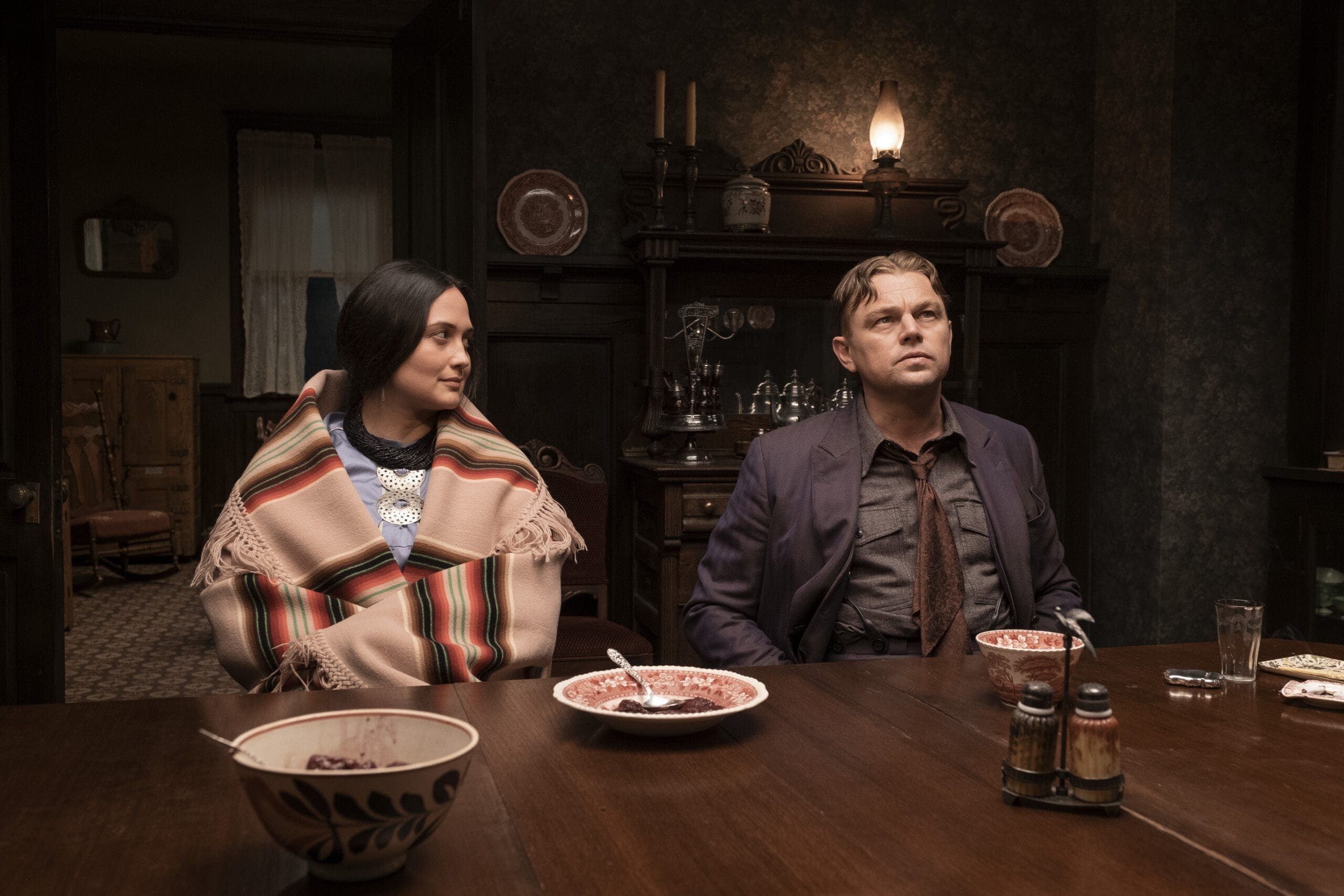
Written by Veda Kota
Music typically helps a story feel more grounded in its setting. In Interstellar, Hans Zimmer transports the audience to faraway cosmic lands. In Oppenheimer Ludwig Göransson utilizes the power of strings and powerful brass to convey the beauty, power and destruction of science. In Martin Scorsese’s Killers of the Flower Moon, scored by the late Robbie Robertson (of The Band), the audience listens to mostly silence, punctuated only by haunting music, the noise of daily life and the occasional gunshot. The silence of Killers of the Flower Moon is almost eerie, forcing the viewers to pay attention to every detail and witness the peak of human sociopathy.
Killers of the Flower Moon is a murder mystery told from the point of view of the murderers: Ernest Burkhart (Leonardo DiCaprio) and William K. “King” Hale (Robert DeNiro). Based on a true story, it follows the duo as they rob, deceive, and murder the Osage Tribe for oil money in 1920s Oklahoma. Mollie Kyle (Lily Gladstone) plays Burkhart’s wife, a woman who communicates with intention and observes every small detail. She flirts with Ernest, knowingly calling him “coyote” and throwing sly glances and smirks in his direction. Her constant voiceovers keep the viewer cemented in the grim reality of Osage people dying and being cast aside without a second thought while grappling with the reality that her husband, the epitome of lazy, greedy, and selfish, continues to ravage the people and town she holds dear.
Originally, Scorsese and co-writer Eric Roth’s screenplay focused on the story from the point of view of the mystery, or rather, a federal agent. DiCaprio was originally supposed to play Tom White, a federal agent tasked with solving the case. However, Scorsese and Roth felt that this narrative angle was failing to tell the whole story, so they instead opted to enshrine the relationship between DiCaprio and Gladstone’s characters and use it as an allegory of how racism and greed fan the flames of hatred, corruption, and deceit.
This proved to be an excellent choice, as the film’s retooling of the central narrative allows for a far more interesting perspective. This choice can best be exhibited in Rodrigo Prieto’s deliberate camerawork and cinematography, with the omniscient viewer feeling almost intrusive at scenes of carnage and important discussions. At one point in the film, DiCaprio’s character and the surrounding neighborhood witness a brutal explosion (via a device that his character planted) and the angle and intensity of the camera makes the viewer feel that they should not be witnessing what was obviously the very brutal final moments of Rita Smith (Janae Collins, Mollie’s sister in the movie). Another scene, which directly contrasts a similar one at the beginning of the film (the naming ceremony) does not utilize the same wide-angle camera shot the first did, conveying just how many Osage were murdered.
A large point of online debate for this movie surrounds the accuracy of Osage representation. Scorsese hired an Osage consultant, Christopher Cote, to supervise the film’s cultural aspects. He told The Hollywood Reporter that he wanted more of the story to be told through Mollie’s perspective, but the movie ended up being almost entirely told through Ernest’s. He added that Scorsese is not Osage and did a great job with representing his people and it would take someone Osage to accurately represent Mollie’s view. Scorsese has spoken about how his numerous meetings with the Osage Nation have changed his story for the better, and at its Cannes debut, Chief Standing Bear (the current chief of the Osage Nation) gave his blessing to the film, stating that it “restored trust.” The discourse is similar to that surrounding Oppenheimer earlier this year. Many lamented the loss of the Japanese perspective in the movie. However, the angle by which these stories are told are not made for the viewer to feel bad for the main character (everyone walked out of Killers and Oppenheimer feeling quite the opposite) but rather see how the characters viewed objectively horrible actions. Burkhart continuously tried to absolve himself of guilt by doing ridiculously intense mental gymnastics, not by admitting guilt.
However, the epilogue of the film is what struck me the most. Many movies about historical events display the aftermath of such events using pictures, somber music, and bold text. They list facts, figures and the consequences of the crimes. Killers takes a different approach by utilizing a radio show format, being read in front of a live audience. The set is complete with live music, sound effects and narration by white radio hosts—with Scorsese making a cameo as the final speaker. The hosts narrate that, essentially, the bad guys got away with a slap on the wrist.
The ending is emblematic of how people think of grisly historical events and murders, as seen in the various true crime podcasts and in the fervor of the true crime community. These events aren’t treated as things that happened, but stories that can be summarized and wrapped into a box with a bow on top. This way of storytelling may bring this story to a wider audience, but more often than not, it eclipses the voices of those who went through the tragedy, ultimately diluting the story and treating crime as a spectacle, not as a horrible event.
Killers of the Flower Moon is deeply unsettling and conveys the depths of human greed and hatred through stunning cinematography, incredible performances, an eerie soundtrack and a powerful ending. I walked out of the theater feeling like I wanted to crawl out of my skin, horrified at this glimpse into the carnage that the U.S. inflicted on hundreds of thousands of Native Americans. This is one of Scorsese’s best (and longest, clocking in at 3 hours and 26 minutes) films and provides non-Osage viewers a morbid display of the cavernous depths of greed, laziness, and racism.

